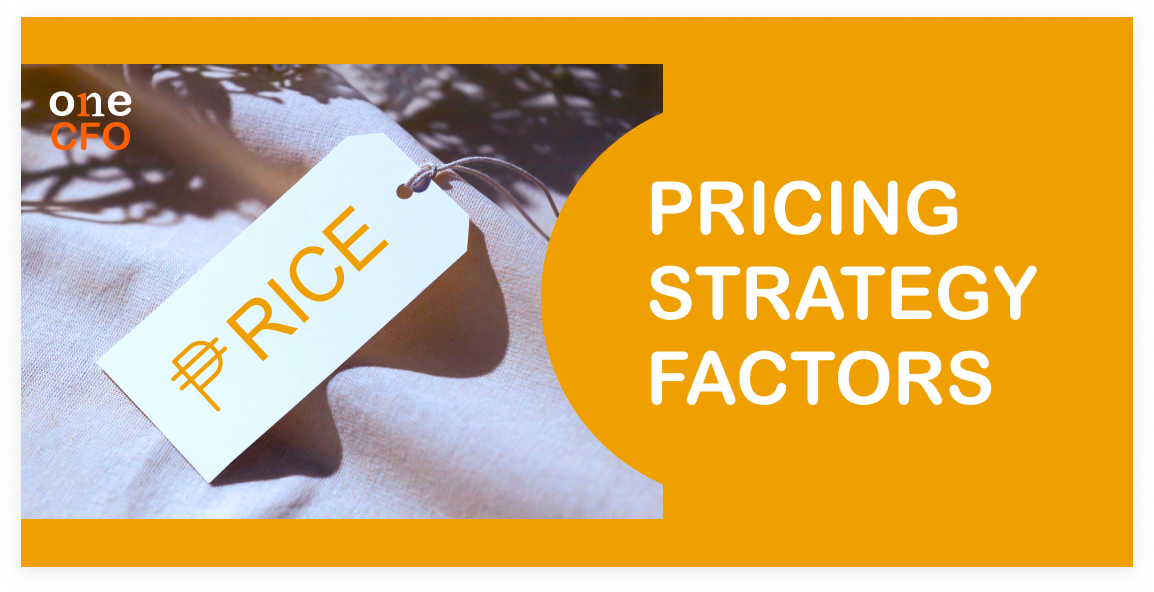
July 7, 2023 | 4:45 pm
Setting the right price for your product or service is one of the most complex decisions a
business owner has to make. Key factors must be considered, as you don’t want to price your
product or service so high that customers will steer clear of it. On the other hand, you
also don’t want to price it too low, compromising profitability.
Effective pricing strategy aims to find that sweet spot your target market is willing to pay
and where you can still earn a profit to keep your business sustainable. However, pricing is
not only a decision you make once.
So, how should you price your product to achieve profitability and sustainable growth?
Different business aspects and economic situations must be analyzed and visited often to
determine pricing and revenue optimization.
This guide dives deep into pricing factors to help small businesses identify optimal pricing
strategies to keep their competitive advantage.
What are the pricing considerations for businesses?
Pricing your products or service is as much an art as a science. You don’t simply compute or choose a specific number - many factors come into play, which small business owners should consider to be competitive in their chosen market.
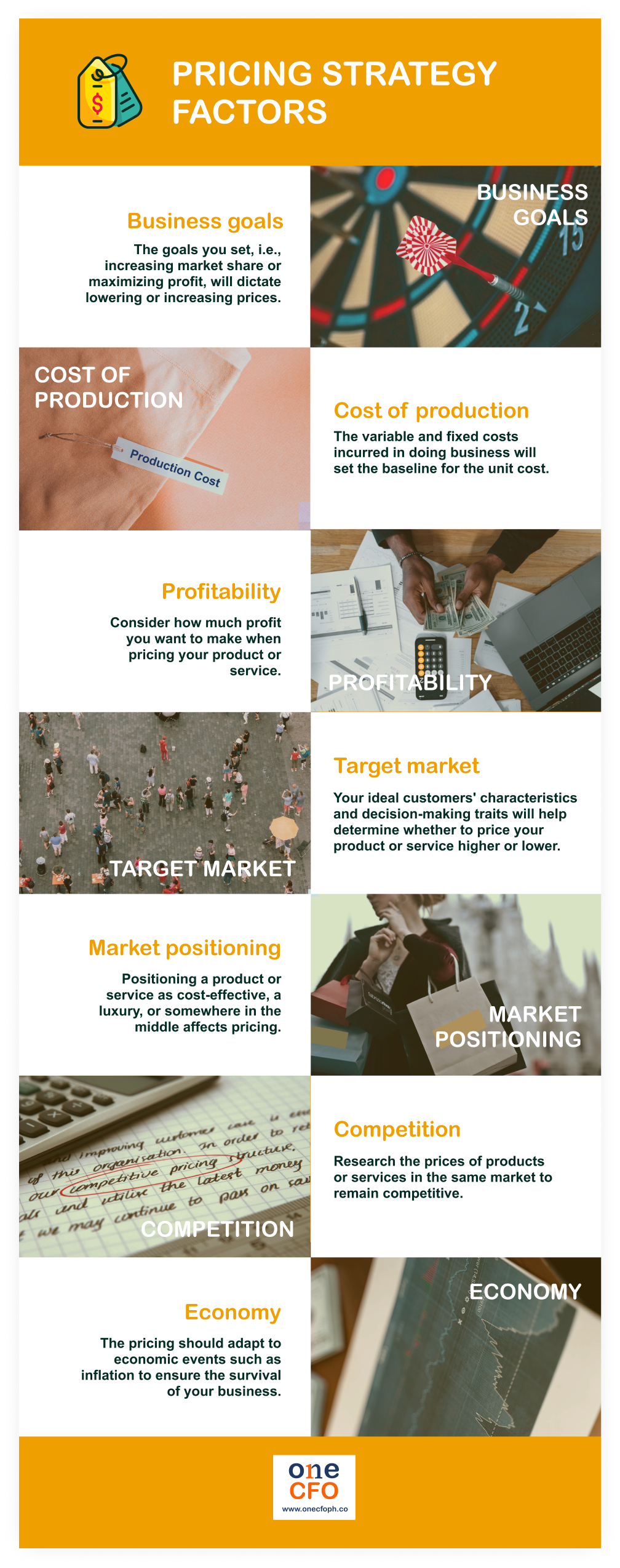
Business goals
Your goals affect the pricing strategy to keep the business at a competitive advantage. Some
common business goals are increasing your market share, maximizing your profits, creating
brand awareness, or being a trendsetter.
For example, if your goal is to increase your market share, opt to lower your prices to
improve sales, attracting more customers and thus widening your customer base.
On the other hand, maximizing profits might mean choosing the highest price the target
market is willing to pay, even if this limits your number of sales. The price increase can
still give more profit with fewer customers compared to selling at a lower price to more
customers.
Whatever business goal you have will dictate your best pricing strategy, so identify your
goals first.
Cost of production
Knowing your costs sets the baseline for pricing - at the very minimum. After all, your
price should always be higher than your costs if you want to turn in a profit and keep your
business running.
When listing your costs, determine the variable and fixed costs.
Fixed Costs vs. Variable Costs
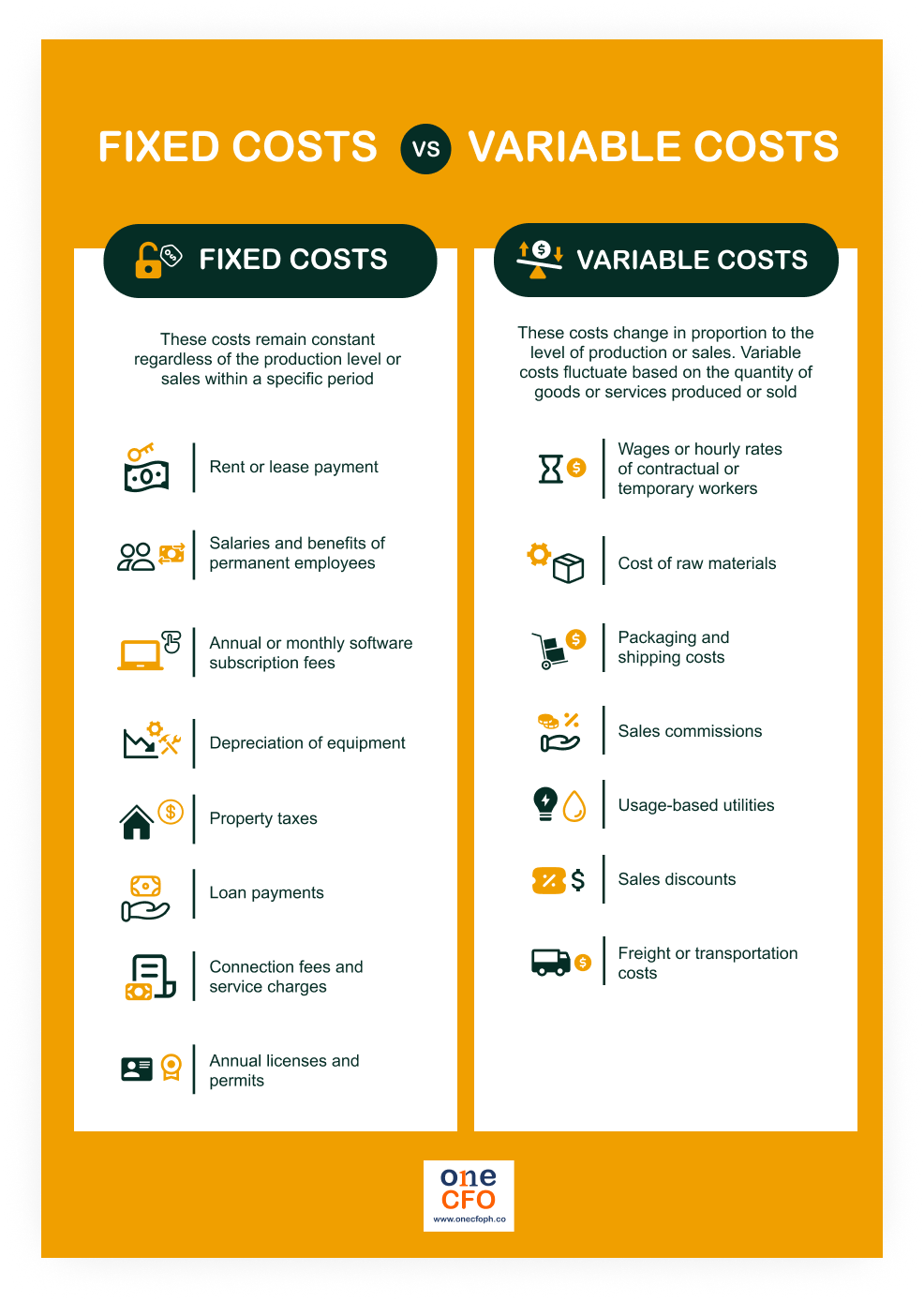
Variable Cost
The direct costs of producing and delivering goods or services are under variable costs.
Variable costs change depending on how many products or services you sell.
For example, in a cupcake business, the more cupcakes you make, the more flour or sugar you
need to buy. The cost of ingredients used to make cupcakes is variable, as this can increase
or decrease depending on the quantities produced.
Another key consideration is the direct material costs that vary based on the quantity
required for each unit produced. Factor in packaging, shipping, and transportation costs, as
these changes depend on the quantity shipped or distance traveled. Usage-based utilities
like electricity or water increase with higher consumption too.
Consider the pricing tactics for increasing sales, such as discounts offered to customers
based on purchase volume or promotional activities. Commissions paid to sales
representatives based on the number of sales generated should also be part of pricing
analysis and decision-making.
Businesses can employ part-time workers when orders are higher or during high volume season.
Wages paid to these workers change, too, depending on the number of hours and hourly rate
and should be part of calculating the selling price of the product or service.
Therefore, variable costs are typically more directly influenced by production or sales
volume changes, making them dynamic expenses that fluctuate as business activities change.
Fixed Cost
Meanwhile, fixed
costs remain stable regardless of how much a company produces or sells.
These are usually overhead costs that are constantly recurring in your business.
For the same example, suppose you’re only renting a space for your bakery. The rental fee is
an example of a fixed cost since you pay the same fee regularly regardless of the number of
cupcakes sold.
Another fixed cost is the salary you want to receive as a business owner and for permanent
employees. Include the expense incurred in paying government-mandated and other fringe benefits.
Consider the fees paid on an annual or monthly subscription and usage or connection fees for
internet or other utilities to achieve optimal pricing.
If you borrowed funds, this entails paying principal and interest, an obligation even if the
sales volume is low.
Licenses and permits, paid to the government to be able to operate annually, are also fixed
costs to consider.
How to calculate the cost per unit
Once you have the total fixed and variable costs, divide the total cost by the number of products produced to get the cost per unit.
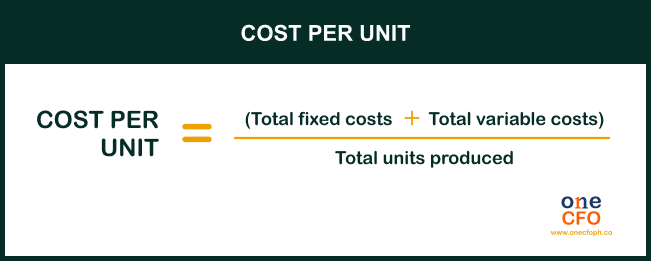
Profitability
After arriving at the cost per unit, the next question to ask yourself is, “How much profit
do I want to make?” Always add a profit margin to determine your selling price.
Pricing is crucial for any business as the selling price should be higher than the cost per
unit. Having enough profit margin in a business is essential to keep it sustainable,
especially when sales are lower than usual.
A good range for a profit margin is 20% to 50%, but consider the other
pricing factors
before choosing a certain percentage. Setting your profit margin too high without proper
justification or research can make selling your products difficult.
How to calculate the selling price of a product
Once you determine the profit margin rate, calculate the selling price by adding the cost
per unit plus the profit margin.
For example, suppose your profit margin is 20%, and the cost per unit is Php 250. This is
how to arrive at your selling price:
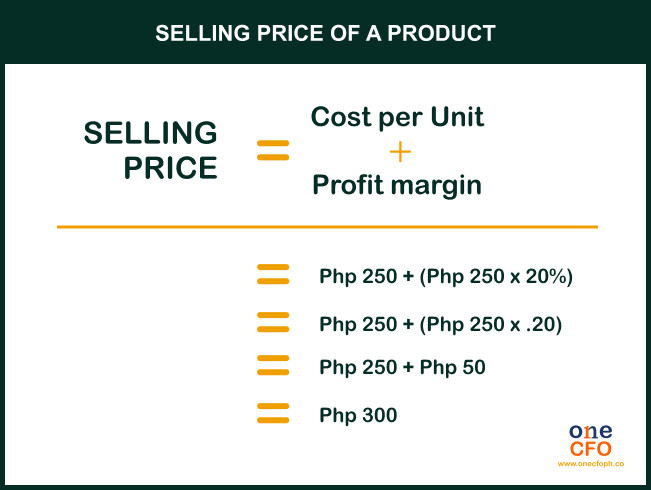
What is LTV:CAC ratio?
To analyze your business profitability deeper, you can also calculate your LTV:CAC ratio or
the lifetime value to customer acquisition cost ratio. Lifetime value (LTV) refers to how
much money you make from an average customer.
Meanwhile, customer
acquisition costs (CAC) refer to how much you spend to get a new
customer, which includes sales and marketing costs.
Ideally, your LTV should be three times greater than your CAC to ensure profitability in
business. If your LTV:CAC ratio is lower than three, conduct a cost analysis to check ways
to minimize marketing costs, increase prices, or find a way to upsell more products to
customers.
Target market
Another critical consideration when choosing a pricing strategy is identifying and
understanding the target market. Are they the type of people willing to splurge on your
product? Or are they the ones always on the lookout for the cheapest price in the market?
Customers have different decision-making styles, which affect
how they see the
value of your
product or service. The important thing is to ensure that the pricing strategy matches
customers' traits or decision-making styles.
Target market segmentation helps determine your value
proposition, what will appeal to them,
and their buying behavior. For example, a more affordable price should be an option if your
target market is from low-income communities.
One way to understand your target market is by conducting buyer persona surveys where you
learn about their demographics, traits, and reasons behind buying your product. You can also
ask them more about their needs to add value to your product.
Market positioning
Knowing your target customers also means choosing your position in the market. Market
positioning means deciding what image you want your customers to perceive about your
product.
Do you want to be known as a luxury status symbol? Or do you want to be known as a low-cost
leader? Of course, market positions are not just limited to these two criteria.
You may settle yourself in the middle, or depending on the urgency of the problem you’re
solving, you could charge premium prices even for average to lower-quality services.
Remember that there are always buyers at different levels of product quality - know how to
position yourself and entice them with attractive product prices.
Competition
Assessing your competition’s prices is also essential when pricing your product. Especially
for new business owners, doing competition or market research can give you an idea of how
much your target market will pay for similar products.
Staying updated on product prices in your industry helps you stay competitive when selling
products or services. However, this doesn’t mean prices should always be lower than everyone
else’s. Instead, know how to justify the product or service's value if you set a higher
price.
Aside from keeping notes of product prices, look at any promos, introductory offers, and
special inclusions your competitors have for their products. Knowing this will also be a
good guide on the unique thing you can offer your customers to stand out.
Economy
Aside from keeping tabs on product prices based on your competitors’ data, consider how
economic factors affect prices in your industry.
For example, prices of raw materials tend to increase during inflation, which means
evaluating the effect of the changes and if there’s a need to raise prices. If you neglect
to adapt to the economic changes, this can affect the business’s survival.
Economic factors can also dictate which industries or products are more in demand, which you
could take advantage of if you want to raise prices.
At the same time, always be ready if business becomes slow due to economic events. A pricing
strategy should help build a cash reserve for times like these to
weather through and keep your business afloat.
Why is pricing strategy important?
Pricing your product is more than just a one-time thing. Your product's pricing evolves as
you gather more customer insights and experience.
Repeatedly consider the different pricing factors to see what would make the most sense for
your product or service. As pricing is a dynamic process, regular monitoring and evaluating
the pricing strategy ensures prices remain effective and competitive.
But if you still don’t know where to start or how you can properly price your products,
OneCFO got your back!
Here at OneCFO, we aim to understand your business and give you CFO-level insights and
advice so you can make the best financial decisions for your business.
Subscribe to OneCFO
services to achieve world-class
finance capabilities without breaking
the bank.
Read our disclaimer here.